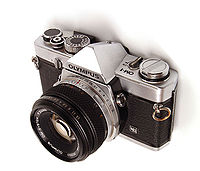
Olympus OM-1
Encyclopedia

Camera
A camera is a device that records and stores images. These images may be still photographs or moving images such as videos or movies. The term camera comes from the camera obscura , an early mechanism for projecting images...
, part of the Olympus OM system
Olympus OM system
The Olympus OM System was a line of 35mm single-lens reflex cameras, lenses and accessories sold by Olympus between 1972 and 2002 ....
.
History
The very first model was presented at the PhotokinaPhotokina
The photokina is the world's largest trade fair for the photographic and imaging industries. The first photokina was held in Cologne, Germany, in 1950, and it is now held biannually in September at the koelnmesse Trade Fair and Exhibition Centre...
of Köln
KOLN
KOLN, digital channel 10, is the CBS affiliate in Lincoln, Nebraska. It operates a satellite station, KGIN, on digital channel 11 in Grand Island. KGIN repeats all KOLN programming, but airs separate commercials...
in 1972 and was called the Olympus M-1. Thirteen years earlier, the release of the Nikon F
Nikon F
The Nikon F camera, introduced in 1959, was Nikon's first SLR camera. It was one of the most advanced cameras of its day. Although most of its concepts had already been introduced elsewhere, it was the first camera to combine them all in one camera. It was produced until October 1973 and was...
had made the 35 mm SLR the standard choice for professionals accustomed to Leica and other rangefinders, but it had driven the market towards heavy and bulky cameras. The Olympus M-1 changed this and with it began a reduction of size, weight and noise of the 35 mm SLRs. It was designed by a team led by Yoshihisa Maitani
Yoshihisa Maitani
Yoshihisa Maitani was a designer of cameras for Olympus after joining Olympus in 1956 he went on to work for them for a further 40 years. He was involved with the design of many of their most well known cameras including the Pen and Pen F half frame cameras, the OM System, the XA and later the...
, who had already created the Pen
Olympus Pen
The Pen series is a family of half-frame cameras made by Olympus from 1959 to the beginning of the 1980s, and from 2009. Aside from the Pen F series of half-frame SLRs, they are fixed-lens viewfinder cameras....
and Pen F
Olympus Pen F
The Olympus Pen F, Pen FT and Pen FV were very similar half-frame 35 mm single-lens reflex cameras with interchangeable lenses produced by Olympus of Japan between 1963-1966 , 1966-1972 and 1967-1970...
cameras, noted for their compactness.
Since Leica's flagship rangefinder cameras are known as the M Series, Leica complained about the name of the M-1 forcing Olympus to rename it as the OM-1 to further clarify between the brands. Because of this, today bodies and lenses with the original M name are rare (5000 bodies were made according to Olympus) and sought after by collectors.
The OM-1 is an all-mechanical SLR. It has a very large viewfinder with interchangeable screens but a fixed prism. It also has a through-the-lens exposure meter controlling a needle visible in the viewfinder. It has a very compact body, essentially retained on later models. One novel feature was the decision to locate the shutter speed dial around the lens mount, rather than on the camera's top plate. A significant advantage of this layout is that the camera can remain at the eye far more easily, between shots, than some other SLRs, it also makes it far easier for "left-eyed" users and enables exposure values to be more rapidly adjusted as the shutter operates in the same plane (effectively around the lens) as the aperture ring. It also less fussy to use than a conventional shutter dial, and easy to sense what shutter speed is being set. With practice both aperture and shutter speed can be adjusted at the same time, made easier by their being reasonably close together but distinct in use.

The OM-1n is the same as the OM-1MD with a redesigned film advance lever, a flash ready/sufficient flash LED in the viewfinder, and automatic X-sync regardless of the position of the FP/X switch, when it is used with a T-series flash unit mounted on Flash Shoe 4.
External links
- Olympus History : OM Series Olympus Corporation History Page.

